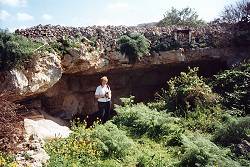Għar tal-Iburdan
Tal-Iburdan Cave
Useful Information
| Location: |
South of Rabat.
From Mdina follow Triq Santa Katarina southwest for 1.5 km, turn right on gravel road at the end of the quarry.
(35.874034, 14.385876) |
| Open: |
no restrictions. [2021] |
| Fee: |
free. [2021] |
| Classification: |
 Catacomb Catacomb
|
| Light: | bring torch |
| Dimension: | |
| Guided tours: | self guided |
| Photography: | allowed |
| Accessibility: | no |
| Bibliography: | |
| Address: |
E-mail: |
| As far as we know this information was accurate when it was published (see years in brackets), but may have changed since then. Please check rates and details directly with the companies in question if you need more recent info. |
|
History
| AUG-2006 | Natura 2000 site. |
| 2010 | scheduled a Class B national monument. |
Description
The cave Għar tal-Iburdan is a habitat for the Lesser mouse-eared bat (Myotis blythii) and the Lesser horseshoe bat (Rhinolophus hipposideros). Thats the reason why it is protected. Its also a prehistoric tomb, bt as far as we know it is not protected for that. It is one of dozens of small catacombs or cave tombs in the area. As the quarry is abandoned, it is quite easy to visit them, although strictly speaking they are on private ground. However, they are under thread by the owner, because they plan a massive concrete plant that will produce almost 2,000 blocks an hour in the abandoned quarry. As it is not of touristic interest the site is currently in an abandoned state.

© Tony Oldham, 25-FEB-2002, with kind permission.
From St Paul’s Catacomb keep walking / driving to the west until you reach the main road. A country lane marked Santa Katerina takes you to an open space near Għar Barka Housing Estate. Do not enter the Estate but take the road to the left towards the hamlet of Santa Katerina (signposted Sta Katerina), and look for a quarry in a field to the right a few hundred meters on. Park on the road and at the far end of the quarry a rough track between the quarry and the houses leads down to a large Girna (corbelled hut) just on the quarry’s edge. Just 15 meters west of this Girna, in the allotments, is one of the entrances to Għar tal-Iburdan. This leads to a chamber 20 meters across and barely a metre high. In the far corner the quarry has opened up another entrance and I fear that this cave might not last much longer.
Excavations in the seventies revealed that the cave was inhabited during the Roman and Byzantine periods. Remains of rustic villas dating back to the Roman times in Malta still exist today, the most renowned being San Pawl Milqui, Ta’ Kaccatura and the remains in the Zejtun [pron ZAY-toon] School. Għar tal-Iburdan contrasts with these by providing evidence for a more humble form of dwelling. During excavations of one of the main rooms of the cave, evidence for trogloditism was provided by the uncovering of a hearth. This was not the only find; remains of meals and a considerable amount of pottery dating back to at least the third century were found. Għar tal-Iburdan is not the only Roman troglodytic dwelling on the islands; Roman levels in a Gozitan cave were also found during the excavation of the Bristol - Cambridge - Malta project. The cave was used again during the 2nd World War when four families from Rabat adopted it as their bomb shelter.
Text by Tony Oldham (2002). With kind permission.
 Search DuckDuckGo for "Tal-Iburdan Cave"
Search DuckDuckGo for "Tal-Iburdan Cave" Google Earth Placemark
Google Earth Placemark L-Għar tal-Iburdan u l-Inħawi tal-Madwar (visited: 11-JUL-2021)
L-Għar tal-Iburdan u l-Inħawi tal-Madwar (visited: 11-JUL-2021) Index
Index Topics
Topics Hierarchical
Hierarchical Countries
Countries Maps
Maps